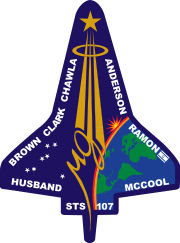STS-107

Launch of Columbia
|
|||||
| Mission type | Microgravity research | ||||
|---|---|---|---|---|---|
| Operator | NASA | ||||
| COSPAR ID | 2003-003A | ||||
| SATCAT № | 27647 | ||||
| Mission duration | 15 days, 22 hours, 20 minutes, 32 seconds | ||||
| Distance travelled | 6,600,000 miles (10,600,000 km) | ||||
| Orbits completed | 255 | ||||
| Spacecraft properties | |||||
| Spacecraft | Space Shuttle Columbia | ||||
| Launch mass | 263,706 pounds (119,615 kg) | ||||
| Landing mass | 232,793 pounds (105,593 kg) (expected) | ||||
| Payload mass | 32,084 pounds (14,553 kg) | ||||
| Crew | |||||
| Crew size | 7 | ||||
| Members |
Rick D. Husband William C. McCool David M. Brown Kalpana Chawla Michael P. Anderson Laurel B. Clark Ilan Ramon |
||||
| Start of mission | |||||
| Launch date | January 16, 2003 15:39:00 UTC | ||||
| Launch site | Kennedy LC-39A | ||||
| End of mission | |||||
| Decay date | February 1, 2003, 13:59:32 UTC Disintegrated during reentry |
||||
| Landing site | Kennedy SLF Runway 33 (planned) | ||||
| Orbital parameters | |||||
| Reference system | Geocentric | ||||
| Regime | Low Earth | ||||
| Perigee | 170 miles (270 km) | ||||
| Apogee | 177 miles (285 km) | ||||
| Inclination | 39.0 degrees | ||||
| Period | 90.1 minutes | ||||
|
|
|||||


Rear (L-R): David Brown, Laurel Clark, Michael Anderson, Ilan Ramon;
Front (L-R): Rick Husband, Kalpana Chawla, William McCool
STS-107 was the 113th flight of the Space Shuttle program, and the disastrous final flight of Space Shuttle Columbia. The mission launched from Kennedy Space Center in Florida on January 16, 2003, and during its 15 days, 22 hours, 20 minutes, 32 seconds in orbit conducted a multitude of international scientific experiments.
The seven members of the crew were killed on February 1 when Columbia disintegrated during reentry into the atmosphere. The Columbia Accident Investigation Board determined the failure was caused by a piece of foam that broke off during launch and damaged the thermal protection system (reinforced carbon-carbon panels and thermal protection tiles) on the leading edge of the orbiter's left wing. During re-entry the damaged wing slowly overheated and came apart, eventually leading to loss of control and disintegration of the vehicle. The cockpit window frame is now exhibited in a memorial inside the Space Shuttle Atlantis Pavilion at the Kennedy Space Center in Florida.
...
Wikipedia
